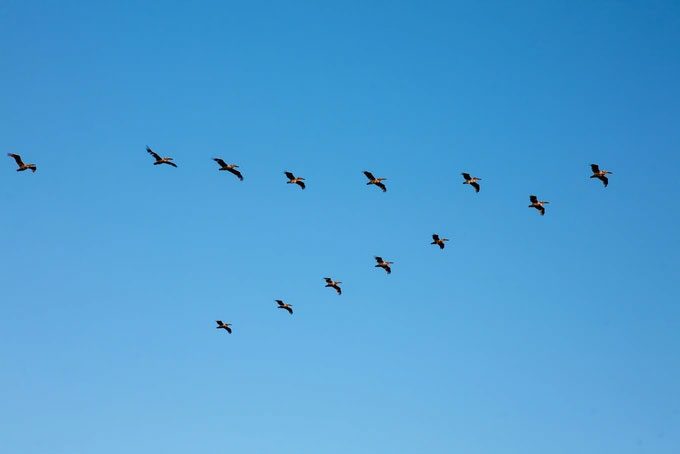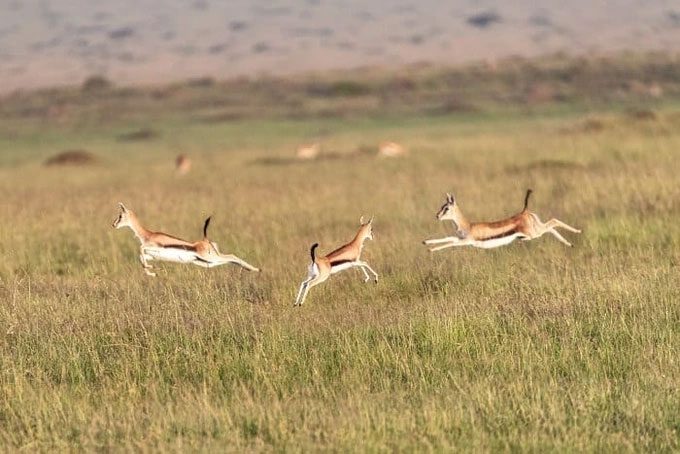We have often heard about cannibalistic animals, but in the natural world, there are many species that sacrifice themselves for the greater benefit of the group.
In the wild, some species are prey to certain animals but are predators to others; for example, a snake may eat a mouse, but later become a meal for an eagle.

Migratory birds flying in a V formation are helping each other on their long journey. (Illustration: Science ABC).
However, some animal species exhibit altruism, which in this context is understood as a tendency of an individual to place the interests of the group or other individuals above its own interests.
Vampire bats, primarily found in the Americas, feed on the blood of other species, yet they are known to share or donate their blood to fellow bats, especially those that have not obtained any food during their hunting trips.
Similarly, some migratory birds embark on long journeys, helping each other during their travels by flying in a V formation (Skein formation).
The separated feathers at the tip of each bird’s wing create small vortices, a phenomenon known as “wing-tip vortices.”
This helps each bird, except for the lead bird (the leader), receive a bit of lift from the vortices created by the bird in front. The lead bird, however, bears the most burden, burning the most energy in the formation while receiving nothing in return.
In both cases, the vampire bat that donates blood and the lead bird during migration expend more energy, sacrificing themselves for the collective benefit of their kind.
Why do these animals act this way?
This question has puzzled scientists, who have yet to explain why such behavior occurs.
Scientist Charles Darwin, the father of the theory of evolution, also seemed to lack an answer. In fact, Darwin indicated that it contradicts his core concept of evolution!

An antelope will alert its herd when it detects a predator, which means it is putting itself at greater risk. (Illustration: Getty).
According to Darwin, natural selection should encourage animals to act in ways that increase their own chances of survival or reproduction. It should not provide survival opportunities to another individual.
However, the opposite can be observed worldwide.
For example, a herd of antelopes (scientific name: impalas) grazing on the grasslands will alert the group when one member detects the presence of a predator, allowing others to flee.
If the first antelope to spot the predator quietly slipped away, it would certainly ensure its own safety. In reality, these animals do not do that; instead, this antelope emits an alarm call, drawing the predator’s attention towards itself to give other herd members a better chance to escape.
If we follow the logic of natural selection, individuals that escape, survive, and reproduce should be favored; so why are individuals like the antelope that warn of danger not eliminated?
To answer these questions, we must consider evolutionary selection mechanisms from a different perspective. We need to start looking at group selection rather than individual selection within species.
In reality, a herd of antelopes on the savannah tends to be altruistic towards one another. No single animal in the herd values its own life more than that of the herd.
Essentially, there is an “all for one, one for all” mentality that they seem to adopt, with each individual acting for the best interest of the group.
However, group selection remains a controversial argument among evolutionary biologists.
This stems from an issue known as “internal defection,” which suggests that even a mutant or “selfish” individual within an otherwise altruistic group can reap the benefits generated by altruists without ever contributing to the group. Essentially, they are free riders.
Yet, while we await definitive conclusions from scientists, the fact remains that even in a world where some species are cannibalistic, there are still many animals that sacrifice themselves to help their companions.


















































